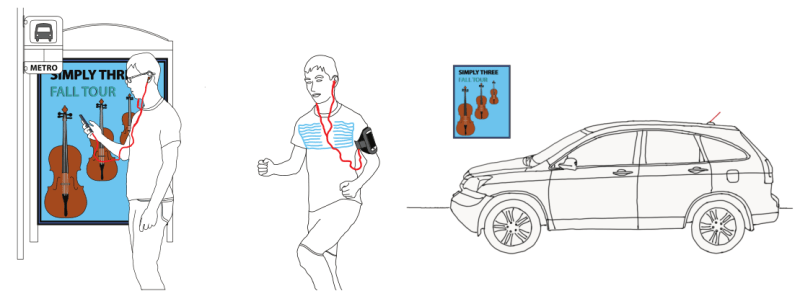If you live in a city, you’re constantly swimming in a thick soup of radio-frequency energy. FM radio stations put out hundreds of kilowatts each into the air. Students at the University of Washington, [Anran Wang] and [Vikram Iyer], asked themselves if they could harness this background radiation to transmit their own FM radio station, if only locally. The answer was an amazing yes.
The trailer video, embedded below, demos a couple of potential applications, but the paper (PDF) has more detail for the interested. Basically, they turn on and off an absorbing antenna at a frequency that’s picked so that it modulates a strong FM signal up to another adjacent channel. Frequency-modulating this backscatter carrier frequency adds audio (or data) to the product station.
One of the cooler tricks that they pull off with this system is to inject a second (stereo) channel into a mono FM station. Since FM radio is broadcast as a mono signal, with a left-minus-right signal sent alongside, they can make a two-channel stereo station by recreating the stereo pilot carrier and then adding in their own difference channel. Pretty slick. Of course, they could send data using this technique as well.
Why do this? A small radio station using backscatter doesn’t have to spend its power budget on the carrier. Instead, the device can operate on microwatts. Granted, it’s only for a few feet in any given direction, but the station broadcasts to existing FM radios, rather than requiring the purchase of an RFID reader or similar device. It’s a great hack that piggybacks on existing infrastructure in two ways. If this seems vaguely familiar, here’s a similar idea out of the very same lab that’s pulling off essentially the same trick indoors with WiFi signals.
So who’s up for local reflected pirate radio stations?
Thanks [João] for the great tip!
















The technique is cool, but it’s hard to find good use cases for it. It would be easier to print a QR code on the poster so you would be directed to the website that has a sound clip on it, plus all the other information. Cheaper too, as it doesn’t require an antenna and electronics.
signal path youtube video of backscatter experiment (as part of a spectrum analyzer review)
https://www.youtube.com/watch?v=RIIv1KyoXss&t=1973s
One perfect application for this would be to transmit sound to an older automotive head unit that lacks any auxiliary inputs.
You could do that better with a small personal FM transmitter. For something like a mp3 player or smartphone, the power consumption is not a problem, and the sound quality will be much better.
Might be interesting to transmit data outside audible frequencies for ads.
Pedant alert: FM radio stations, in the USA at least, don’t generally put out “hundreds of kilowatts each into the air”. FM radio stations typically range from the single watts up to 50kW, with a few that are located just-so (or grandfathered) that can put out more than that. In the USA (and territories), there are only a handful that radiate greater than 100kW (KPFK, WBCT, KQED, KIOI, WNCI, KZZO, off the top of my head, though some of those may have changed call signs or reconfigured and gone below 100kW ERP and I’m sure I missed a few others). While many TV stations certainly broadcast at hundreds of kilowatt levels, FM radio stations (with their much-narrower-than-TV bandwidth) don’t typically do so.
FM radio broadcast power (ERP), like any other RF signal, is limited by the law of diminishing returns… distance from transmitter functions as an inverse square to power (twice as much power gets you half again as far), and chasing that outward quickly becomes ridiculously costly, especially when most areas of coverage are reasonably covered by a medium-strength signal and pushing it that much farther outward throws a lot of money at comparatively fewer ears than what they’re reaching closer-in. There are exceptions, of course, but FM Radio owners have repeatedly learned over the past decade or two that money doesn’t grow on trees, and so spending what they have on maximizing their raw power just doesn’t pay off.
Pedant mode off.
Meh! Fair enough.
97.1 KEGL in DFW is 100kW ERP
Any pictures of the oscillator that can throw 100kW into the ether? A friend’s father was a HAM whose job happened to be the engineer for a Brisbane AM radio station in the 60s/70s. Apparently the transmitter lived in a locked cage – no unauthorised personnel near the multi-kW equipment. GREAT BIG VACUUM TUBES!
It’s worse than just the law of diminishing returns. Due to the frequencies involved (not due to the mode) the FM broadcast band is usually just line of sight! Sure, a 100KW station might be receivable at a farther distance but that distance is in a straight line from the transmitter. Since the Earth is curved that means it is somewhere out in space! I don’t think many earthbound stations have a lot of listeners out there yet!
What I’m not quite sure about is why FM broadcast stations even need to be as powerful as they are. Ham radios in the VHF bands where propagation is similar make pretty good contact within their line of sight regions using just a few 10s of watts. The only reasons for the power that I can think of are to try to punch their way into the interiors of thick buildings or maybe just to compete with all the other broadcasters covering the same area.
Well.. that and bandwidth. Broadcast stations have much wider bandwidth which does mean they will require more power but at a factor of 10s of thousands?!?
Cool idea. Did they actually prototype a working system using the IC design (no batteries) or is this designed on paper-only for now?
Imagine turning a person into a bug.
Saw the original movie and also the remake, would watch again.
Cool. New type of geocrate, or advertising